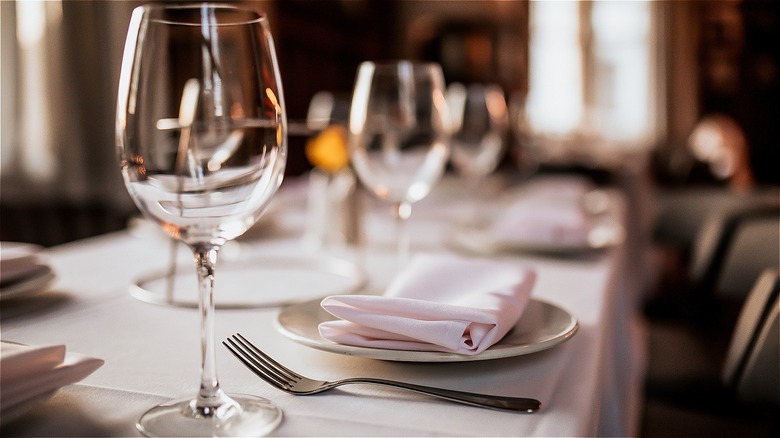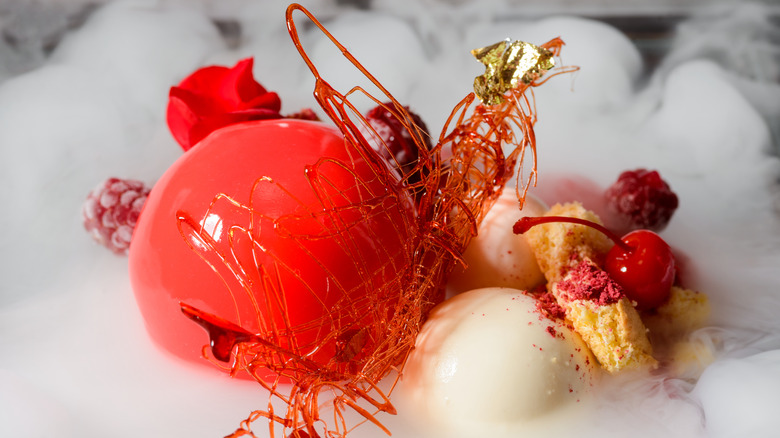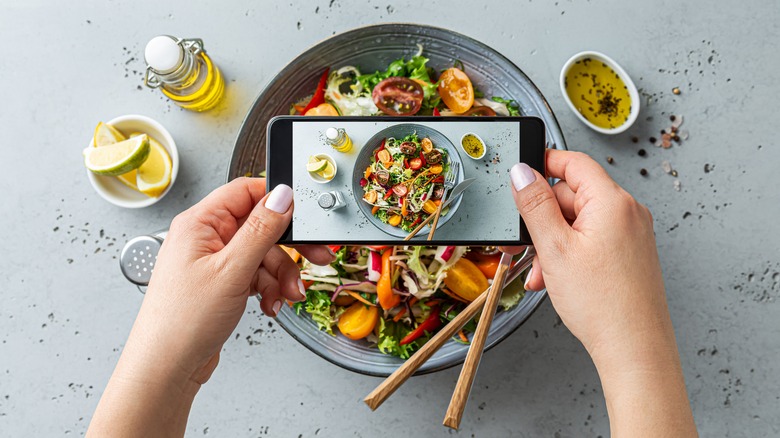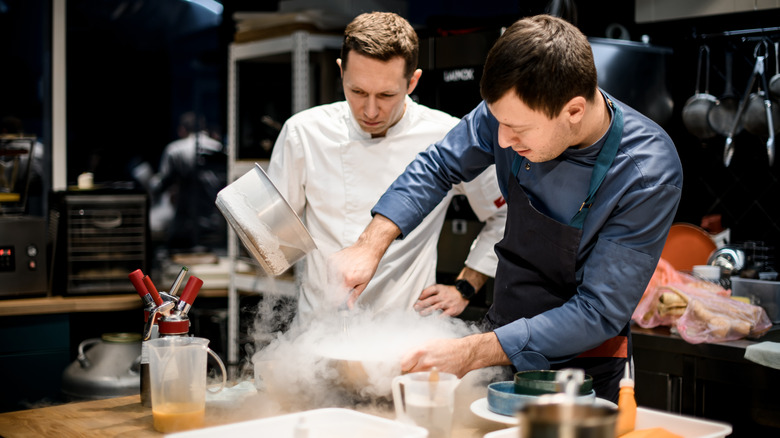Fine Dining Has Become A Guilty Pleasure — And That's Not A Good Thing
Nickelback, Nicholas Sparks novels, and pineapple on pizza are classic examples of guilty pleasures you should enjoy when no one's looking. Because, duh, dad-rock and "The Notebook" peaked in 2008 and tangy cheese is just offensive. But what about less-obvious guilty pleasures? Sometimes, even the most shameful amusements were once respectable indulgences held in the highest regard. And, no, we're not talking about your gone-on-too-long Wordle addiction.
We are, though, talking about fine dining. What used to be — and fundamentally still is — an art form, has become a parody of itself. While cuisine is explorative and experimental in nature, where do we draw the line between absurdity and art? When does haute cuisine become a distasteful cliché? Upscale dining has lost its human element in exchange for a chance to win the award for the most impractical, on-the-nose, derivative dish in fine dining.
As it continues diminishing its own reputation with empty luxuries and comical offerings, the fine-dining industry itself is suffering from mass call-outs thanks to movies like "The Menu" and its culinary themes of breadless bread and deadly s'mores. If it doesn't find its way back to authenticity, haute cuisine, and the late great Noma's ant-topped delicacies will soon be filed next to Rick Astley's "Never Gonna Give You Up" in the big book of guilty pleasures.
There's a difference between creative and cliché
Everyone loves a plate brimming with color, protein, greens, and grains all arranged with space, angles, and feng shui. Streaks of sauce plated with the brush strokes of Monet and Renoir in mind, towers of seafood elegantly balancing atop a blossoming assortment of leafy greens and seasonal vegetables — these are elements of fine dining that can stir not just the appetite, but the visual, spiritual senses as well.
However, when a waiter draped in white brings out a plate of brains with a side of spicy rice in the shape of molecular gastronomy slime, it's hard not to bite your tongue. It's not about yucking anyone's yum, though. Chefs and everyday people alike from different cultures across the world eat foods that might look, smell, and taste foreign; but nothing that gives a hungry person vitality and life should be considered a guilty pleasure.
But when chefs at upscale restaurants serve outrageous, unidentifiable plates made only with ingredients designed to outshine the Michelin-star restaurant that offers vapor shots and edible helium balloons, it loses its artistic, cultural significance and becomes a game of "whose plate is more ridiculous."
Meals can be experimental, unusual, and even unsettling. They can be colorful, textured, and inspired by folklore and feelings. But nothing screams cliché quite like an "upscale" meal that follows the fame-first formula and serves no purpose other than to feed the ego of a culinary creator who just wants their insulting amuse-bouche to land a spread in the New York Times.
Food influencers exacerbate the problem
Social media has the power to accelerate a simple moment in time into a full-fledged movement in the blink of an eye. Not only do social media trends sweep the digital masses, but the very people who start the trends also become a movement in and of themselves. Like Brad and Angelina in the mid-2000s, social media influencers are exalted by everyday people who look to something more luxurious than themselves to deal with the mundane realities of being human.
But social media influencers are more than just fitness coaches and lifestyle gurus peddling the latest innovations in volumizing mascaras: They're also foodies, nutritionists, and chefs. Millions of people across the social media sphere find recipes and restaurant suggestions from food influencers. And while these social media professionals offer handy recommendations for seasonal produce and the hottest new gastropub on the Lower East Side, they also encourage restaurants to create Instagram-worthy dishes rather than plates that come from the soul.
Because we live in a society that thrives on documenting every minute detail of every day, there's little room for enjoying ordinary pleasures. Nine times out of ten, a bubbling purple stew served in a witches cauldron will outperform a classic tomato basil soup on social media, even when the boring old tomato soup is both better prepared and better tasting.
When food influencers make outrageousness the standard, restaurants will follow suit. Not only will these restaurants weasel their way into a "top 10 most out-of-pocket meals in America" list, but they'll be tagged across thousands of Instagram, Facebook, and Twitter posts by everyday people who just had to try a heaping bowl of seasoned, steamed ice.
Fine dining doesn't have to be gaudy
True fine dining is about experiencing the endless possibilities that exist between culture, flavor, texture, and aroma. It's about making a connection between human emotion and the food that fuels us. Fine dining and haute cuisine bridge the gap between art and survival by creating dishes that enrich both the body and the creative mind.
It's the hoi polloi that diminishes the robust bounty of haute cuisine. The desire to be perceived as gaudy and grand outshines the altruistic nature of genuine fine dining. Simplicity, stories, and soul are enough to bring fine dining back down to earth, but it requires a great deal of collective self-reflection and the confidence to create and consume dishes with meaning.
Until then, you might want to keep your fine-dining TikTok review in your back pocket. It pairs nicely with your "Nickelback's Greatest Hits" CD.



